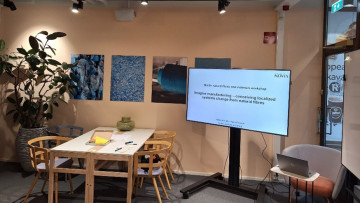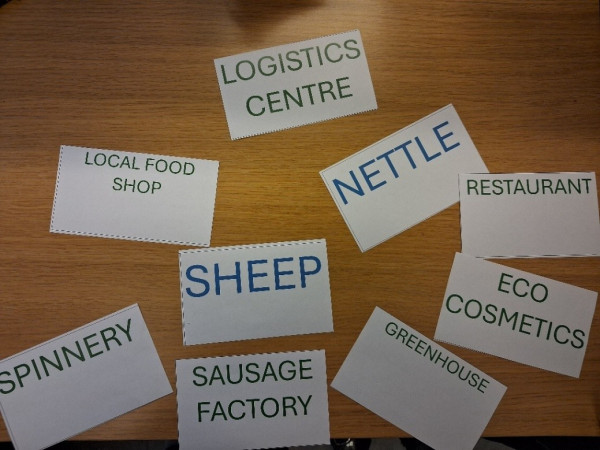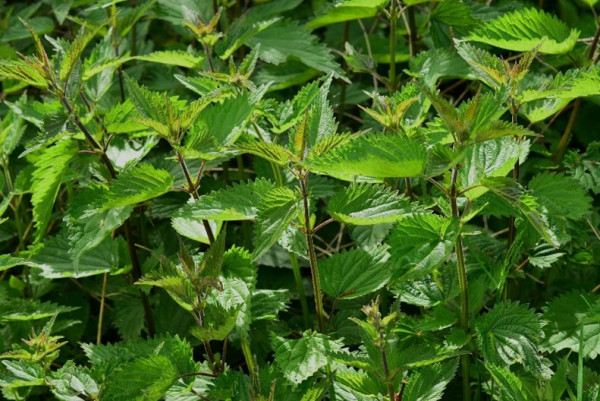
Bloggar
Imagine Manufacturing: a workshop on natural fibres and materials in local systems

Flax, nettle, hemp and wool are all natural fibres that are produced or can be produced in the Nordic countries. Leather is a natural material that occurs mostly as a byproduct from meat production. All these materials are connected to food production and agriculture. How would you structure a regional business around one of them? We asked a group of researchers, students and experts in different areas this question at a workshop at the Science for Sustainability conference in Helsinki in October. The results were creative and showed an understanding of the complexity of supply chains but also made common knowledge gaps and bottlenecks visible.
First, we started with a short presentation about natural fibres and materials. Then, the participants, who had been divided into four groups, got to choose a main production focus from the following alternatives: flax, hemp, nettle, sheep, cow and alpaca. After that, they chose three partners to support their business, from pre-defined alternatives. The available partners were, for example, a spinnery, a leather tannery, weaving, a logistics center, eco-cosmetics production, a butcher or a farm shop. Once the imaginary businesses were established, the groups started networking with each other, to find additional partners and networks to collaborate with.

An example of cards used in the worshop. Photo: Ulrika Dahlberg
Interesting questions that arose during the workshop were, whether vegan businesses could collaborate with animal producers, and if plant- and animal fibres can be mixed. Somebody was asking what the difference between spinning and weaving is. The answer is that spinning is when the fibres are made into yarn and weaving is when the yarn is made into fabric. All this has been common knowledge when textile production and maintenance was done in homes, but when both food and textile production has moved further away from the consumer, many things concerning production and processing have become unfamiliar.
The business solutions the groups came up with were:
- Hemp cultivation with a fibre processing facility and spinnery, and some expertise in marketing and export. The farm would collaborate with group number 2 in weaving textiles, with a designer, sowing facility and logistics center in group number 3, and create a new fibre mix with nettle from group 4.
- Sheep production, shearing (cutting wool), a butcher, a dairy plant and a restaurant. Spinning and export will be done in collaboration with group 1, wool sweaters will be produced with the designer in group 3, as well as sharing a logistics facility. The restaurant will collaborate with a hotel in group 4.
- Production of flax, mixed with nettle and hemp from other groups. Collaboration with fibre processing and spinnery (1), weaving (2), designer (3), marketing (1) and producing textiles, such as sheets for the hotel (4). Collecting flax seeds and selling them at their own farm shop together with other local products. Collaboration with the local food shop in group 4. This group chose to have a logistics center that also serves other businesses in the area.
- Focus on nettle production and greenhouse production, manufacturing eco-cosmetics, running a local food shop and a hotel.

Nettle is a plant that can be used as food, feed, fibre, in cosmetics and nutrient supplements, or to make fertilizer. Picture from Unsplash.
Besides the lines of production the participants chose, it was interesting to see what was left on the table. A common bottleneck in the wool supply chain in the Nordics is scouring (washing wool), which nobody in the workshop chose to engage in. The solution for many businesses is to send the wool to be washed in England and then have it shipped back. Perceptions of sustainability may have steered the participants to focus on plant fibres, leaving the cow and alpaca, as well as the sausage factory and tannery, on the table. One exception was group 2, that chose sheep, dairy and a butcher. This also made the dialogue between plant and animal production interesting. Also, probably because of lack of time and too much complexity, not many thought about using the other streams from fibre production, except for group 3, who planned to also collect and sell the seeds from fibre flax. Other examples of this could have been a pellet factory, making fertilizer of the wool that is too dirty or low quality to be used for textiles.
In general, the feedback from the workshop was good, and encouraged us to organize similar events in the future. The participants wrote in a feedback form that they had learned about production and processing, bottlenecks, supply chains, market shares of natural fibres and how many different areas are needed to create collaborations. One participant mentioned that the links with sustainability could have been addressed more, e.g. comparing emission factors of the materials, which we will keep in mind for next time.
Experiences from the following projects were used in the workshop:
NyNässla – Nettle for fibre and food in Uusimaa is carried out in collaboration with Nylands Svenska Lantbrukssällskap at Västankvarn research farm. Funding has been granted from the European Union, via the Uusimaa Centre for Economic Development, Transport and the Environment (ELY Centre), Svenska kulturfonden and Stiftelsen Finlandssvenska Jordfonden.
NorNa – Nordic Natural Fibres in Circular Economy is an information project about natural fibres, such as flax, hemp, nettle and sheep wool. Funding is granted from Svenska kulturfonden.
F.E.L.T. WOOL – Future Emergence of Local Textiles Based on WOOL is funded by NordPlus Horizontal and focuses on finding ways to use coarse wool in felted products in the Nordic and Baltic countries.

The blogpost has been reviewed by Novia's editorial board and accepted for publication on 24.10.2025.
![]()
Bioekonomi
Blogginlägg som är granskat av Novias redaktionsråd är utmärkta med nyckelordet "Granskat inlägg".
Vi följer CC-BY 4.0 om inget annat nämns.
Ansvarsfriskrivning: Författaren/författarna ansvarar för för fakta, möjlig utebliven information och innehållets korrekthet i bloggen. Texterna har genomgått en granskning, men de åsikter som uttrycks är författarens egna och återspeglar inte nödvändigtvis Yrkeshögskolan Novias ståndpunkter.
Disclaimer: The author(s) are responsible for the facts, any possible omissions, and the accuracy of the content in the blog.The texts have undergone a review, however, the opinions expressed are those of the author and do not necessarily reflect the views of Novia University of Applied Sciences.